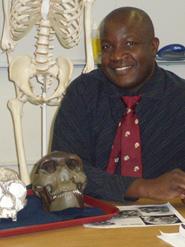
Nasser R. Malit
Associate Professor, Biological Anthropology
Nasser Malit, Ph.D.
Dr. Nasser Malit holds a BA in Anthropology from the University of Nairobi, as well as an MA and PhD in Paleoanthropology from SUNY Binghamton, New York. He has extensive fieldwork experience in paleontology, archaeology, and forensic science. Over the years, Dr. Malit has spearheaded independent research projects and collaborated with leading researchers in the field.
His current work focuses on the Plio-Pleistocene fossil sites in the Central Highlands of Kenya (CHK), which have produced significant discoveries, including hominin remains and archaeological artifacts. These findings are crucial for expanding our understanding of human evolution beyond the Rift Valley System.
Dr. Malit also serves as the Principal Investigator for the Buffalo Springs Project in Samburu, where he led the excavation of a nearly complete early Holocene human skeleton, now awaiting formal dating. Additionally, his research in the Miocene deposits of Sibiloi marks the first formal documentation of a petrified forest in Kenya. This project holds significant implications for studying climate change during the Middle Miocene in the Turkana Basin and for understanding the emergence of C4 grasses. Beyond Sibiloi, Dr. Malit has contributed to research at other Miocene sites, including Locherangany, Lothagam, and Buluk in the Lake Turkana Basin, as well as Songhor in western Kenya. His expertise extends to identifying human and faunal remains, and he consults with the New York State Troopers Forensic Unit, aiding with human identification cases.
Dr. Malit has a strong commitment to mentoring students, actively involving them in his research during his tenure as a faculty member at SUNY Potsdam. He has also published on fossil remains from Kenya, further enriching the field with his findings and insights.
Selected Publications and Presentations
2025 Malit, N.R., Kirera, K. M., Waweru, V., Sveshnikova, A., Miggins, D.P., Ngalla, J., Omuombo, C., Kinyanjui, R., Grossman, A., Muchemi, F., Chege, L. N. Mwangi, J., & Kinyua, R. An Assessment of Stature and Ecogeographic Profile of Human Remains from A Medieval Burial in the Central Highlands of Kenya. Annual Meeting of the Paleoanthropology Society, April 22-23, 2025. Denver, CO.
2024 Henkes, G., Beck, C., Feibel, C., Poulsen, C. J., Uno, K. T., Bahadori, A., Becel, A., Cox, S. E., Fortelius, M., Green, D. R., Hemming, S., Holt, W., Kinyanjui, R. N., Liutkus-Pierce, C. M., Malit, N., Mana, S., Miller, E., Rowan, J., Rasbury, E. T., Russo, G., Smiley, T., Sousa, F., Stinchcomb, G. E., Ungar, P. S., Vitek, N., žliobaite, I., & Other TMP Members. (2024). Miocene landscape reconstruction and faunal evolution in Kenya's Turkana Basin: A report from the Turkana Miocene Project. Geological Society of America Abstracts with Programs, 56(5). https://doi.org/10.1130/abs/2024AM-402921
Kirera, Francis M., Malit, N., Kinyanjui, R., Omuombo, C., Muchemi, F., Waweru, V., Grossman, A., Muge, S., & Kinyua, R. (2024) New fossiliferous and archeological sites in the central highlands of Kenya. Abstract, Addis Ababa, Ethiopia, EAAPP.
2023 Malit, N.R., Baab, K. L., Kirera, K. M., Waweru, V., Daniel P. Miggins, D.P., Ngalla, J., Omuombo, C., Kinyanjui, R., Grossman, A., Nderitu, F., Chege, L. N. & Kinyua, R. (2023). The first occurrence of a Middle Pleistocene Hominin from the Central Highlands of Kenya. AABA Abstract. Reno, NV.
Kinyanjui, R. N., Grossman, A., Kirera, F. M., Waweru, V., Malit, N.R., Omuombo, C., Mashaka, H., Chege, L. N., Nderitu, F., & Kinyua, R. (2023) Newly discovered Plio-Pleistocene sites in west Mt. Kenya: Potential tropical high-elevation refugia? PAGES Mag. Vol. 31, No. 1:26-27. https://doi.org/10.22498/pages.31.1.26
2014 Cote, S., Malit, N. and Nengo, I. Additional mandibles of Rangwapithecus gordoni, an early Miocene catarrhine from the Tinderet localities of Western Kenya. Am J Phys Anthropol 153 (3) p. 341-512.
2013 Malit, N. Are the Neandertals Finally Becoming Human? In: Ellis E. Mcdowell-Loudan, Editor. Human Evolution and Survival: Candid Conversations on the Human Story. Cognella Academic Publishing. p. 43-78.
2009 Gebo, D., Malit, N. and Nengo I. O. New proconsuloid postcranials from the early Miocene of Kenya. Primates.50:311-399.
2003 Malit, N. R., Ngalla, J. E. & Kirera, F. M. The palaeoenvironmental interpretation of the Plio-Plestocene locality of Gatarakwa, Central Kenya, and its significance in understanding hominid evolution. Am. J. Phys. Anthropol. Vol. 120, S36:145.
Courses Taught:
WAYS 101 Apes Got Culture?
ANTH 120 Evolution
ANTH 184 The Primates
ANTH 201 Human Origins
ANTH 301 Issues in Physical Anthropology
ANTH 302 Advanced Forensic Anthropology
ANTH 347 Human, Diseases and Death (Evolutionary Medicine)
ANTH 356 Neanderthals, Fact, Fiction and Fantasy
ANTH 365 Archaeology of Death
ANTH 380 Human Osteology
ANTH 392 Anthropological Teaching Methods
ANTH 402 Forensic Anthropology
ANTH 403 Advance Biological Anthropology, Research
ANTH 480 Anthropology Senior Seminar
